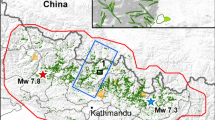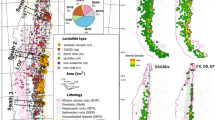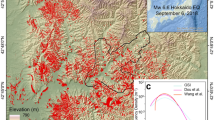Abstract
Shallow earthquakes are the primary driver of rock uplift in mountain ranges1. However, large shallow earthquakes also trigger widespread, coseismic landslides that cause significant but spatially heterogeneous erosion2,3,4. The interplay between rock uplift and the distribution and magnitudes of coseismic landslides thus raises a fundamental question as to whether large earthquakes and their associated landslides create or destroy mountainous topography. The 2008 Mw 7.9 Wenchuan earthquake in Sichuan, China triggered more than 56,000 landslides5, with a spatial distribution that was only partly related to the pattern of tectonic deformation6. Here we examine the potential changes in orogen volume using landslide area–volume scaling relationships4,7 applied to high-resolution satellite imagery. We estimate that coseismic landsliding produced ∼5–15 km3 of erodible material, greater than the net volume of 2.6±1.2 km3 added to the orogen by coseismic rock uplift8. This discrepancy indicates that, even if only a fraction of the landslide debris is removed from the orogen over the likely ∼2000–4000 yr earthquake return period6, the Wenchuan earthquake will lead to a net material deficit in the Longmen Shan. Our result challenges the widely held notion that large dip-slip or oblique-slip earthquakes build mountainous topography, and invites more careful consideration of the relationships between coseismic slip, mass wasting and relief generation.
This is a preview of subscription content, access via your institution
Access options
Subscribe to this journal
Receive 12 print issues and online access
$259.00 per year
only $21.58 per issue
Buy this article
- Purchase on Springer Link
- Instant access to full article PDF
Prices may be subject to local taxes which are calculated during checkout


Similar content being viewed by others
References
Avouac, J. P. in Crustal and Lithosphere Dynamics (ed. Watts, A. B.) 377–439 (Treatise on Geophysics, Vol. 6, Elsevier, 2008).
Keefer, D. K. The importance of earthquake-induced landslides to long-term slope erosion and slope-failure hazards in seismically active regions. Geomorphology 10, 265–284 (1994).
Malamud, B. D., Turcotte, D. L., Guzzetti, F. & Reichenbach, P. Landslides, earthquakes and erosion. Earth Planet. Sci. Lett. 229, 45–59 (2004).
Larsen, I. J., Montgomery, D. R. & Korup, O. Landslide erosion caused by hillslope material. Nature Geosci. 3, 247–251 (2010).
Dai, F. C. et al. Spatial distribution of landslides triggered by the 2008 Ms 8.0 Wenchuan earthquake, China. J. Asian Earth Sci. 40, 883–895 (2011).
Shen, Z. K. et al. Slip maxima at fault junctions and rupturing of barriers during the 2008 Wenchuan earthquake. Nature Geosci. 2, 718–724 (2009).
Guzzetti, F., Ardizzone, F., Cardinali, M., Rossi, M. & Valigi, D. Landslide volumes and landslide mobilization rates in Umbria, central Italy. Earth Planet. Sci. Lett. 279, 222–229 (2009).
de Michele, M., Raucoules, D., de Sigoyer, J., Pubellier, M. & Chamot-Rooke, N. Three-dimensional surface displacement of the 2008 May 12 Sichuan earthquake (China) derived from Synthetic Aperture Radar: Evidence for rupture on a blind thrust. Geophys. J. Int. 183, 1097–1103 (2010).
Hovius, N., Stark, C. & Allen, P. Sediment flux from a mountain belt derived by landslide mapping. Geology 25, 231–234 (1997).
Densmore, A. L., Ellis, M. A. & Anderson, R. S. Landsliding and the evolution of normal fault-bounded mountains. J. Geophys. Res. 103, 15203–15219 (1998).
Whipple, K. X. The influence of climate on the tectonic evolution of mountain belts. Nature Geosci. 2, 97–104 (2009).
Hovius, N., Stark, C. P., Chu, H. T. & Lin, J. C. Supply and removal of sediment in a landslide-dominated mountain belt: Central Range, Taiwan. J. Geol. 108, 73–89 (2000).
Hovius, N. et al. Prolonged seismically induced erosion and the mass balance of a large earthquake. Earth Planet. Sci. Lett. 304, 347–355 (2011).
Sato, H. P. & Harp, E. L. Interpretation of earthquake-induced landslides triggered by the 12 May 2008, M7.9 Wenchuan earthquake in the Beichuan area, Sichuan Province, China using satellite imagery and Google Earth. Landslides 6, 153–159 (2009).
Burchfiel, B. C., Chen, Z., Liu, Y. & Royden, L. Tectonics of the Longmen Shan and adjacent regions. Int. Geol. Rev. 37, 661–735 (1995).
Li, Y., Allen, P. A., Densmore, A. L. & Qiang, X. Evolution of the Longmen Shan Foreland Basin (Western Sichuan, China) during the Late Triassic Indosinian Orogeny. Basin Res. 15, 117–138 (2003).
Densmore, A. L. et al. Active tectonics of the Beichuan and Pengguan faults at the eastern margin of the Tibetan Plateau. Tectonics 26, TC4005 (2007).
Liu-Zeng, J. et al. Coseismic ruptures of the 12 May 2008, Ms 8.0 Wenchuan earthquake, Sichuan: East–west crustal shortening on oblique, parallel thrusts along the eastern edge of Tibet. Earth Planet. Sci. Lett. 286, 355–370 (2009).
Meunier, P., Hovius, N. & Haines, J. Regional patterns of earthquake-triggered landslides and their relation to ground motion. Geophys. Res. Lett. 34, L20408 (2007).
Ran, Y. et al. Paleoseismic evidence and repeat time of large earthquakes at three sites along the Longmenshan fault zone. Tectonophysics 491, 141–153 (2010).
Lin, A., Ren, Z., Jia, D. & Miyairi, Y. Evidence for a Tang–Song dynasty great earthquake along the Longmen Shan Thrust Belt before the 2008 Mw 7.9 Wenchuan earthquake, China. J. Seismol. 14, 615–628 (2010).
Ouimet, W. B., Whipple, K. X. & Granger, D. E. Beyond threshold hillslopes: Channel adjustment to base-level fall in tectonically active mountain ranges. Geology 37, 579–582 (2009).
Kirby, E., Whipple, K. X., Tang, W. & Chen, Z. Distribution of active rock uplift along the eastern margin of the Tibetan Plateau: Inferences from bedrock channel longitudinal profiles. J. Geophys. Res. 108, 2217 (2003).
Dadson, S. J. et al. Earthquake-triggered increase in sediment delivery from an active mountain belt. Geology 32, 733–736 (2004).
Godard, V. et al. Late Cenozoic evolution of the central Longmen Shan, eastern Tibet: Insight from (U–Th)/He thermochronometry. Tectonics 28, TC5009 (2009).
Perfettini, H. et al. Seismic and aseismic slip on the Central Peru megathrust. Nature 465, 78–81 (2010).
Freed, A. M., Bürgmann, R., Calais, E., Freymueller, J. & Hreinsdóttir, S. Implications of deformation following the 2002 Denali, Alaska, earthquake for postseismic relaxation processes and lithospheric rheology. J. Geophys. Res. 111, B01401 (2006).
Hsu, Y. J. et al. Frictional afterslip following the 2005 Nias-Simeulue earthquake, Sumatra. Science 312, 1921–1926 (2006).
Orphal, D. L. & Lahoud, J. A. Prediction of peak ground motion from earthquakes. Bull. Seismol. Soc. Am. 64, 1563–1574 (1974).
Ouimet, W. B. Landslides associated with the May 12, 2008 Wenchuan earthquake: Implications for the erosion and tectonic evolution of the Longmen Shan. Tectonophys 491, 244–252 (2010).
Acknowledgements
Funding for this research was provided by NERC grant NE/G002665/1, National Natural Science Foundation of China grant 40841010, and the Willis Research Network. M.d.M. was supported by BRGM Research Direction. We thank N. Cox, T. Dewez, N. Hovius, B. Malamud, P. Meunier, D. Milledge, D. Raucoules, R. Schultz, H. Tomlinson, O. Tomlinson, Z. Yan and Y. Zhang for assistance.
Author information
Authors and Affiliations
Contributions
R.N.P. and S.W. conducted the landslide mapping and analysis. A.L.D., S.W., Y.L., R.H. and D.N.P. collected field data on the rupture and landslide characteristics. M.d.M. derived the tectonic mass flux. A.L.D. conceived the idea and wrote the paper with input from R.N.P., N.J.R., D.N.P. and M.d.M.
Corresponding author
Ethics declarations
Competing interests
The authors declare no competing financial interests.
Supplementary information
Supplementary Information
Supplementary Information (PDF 2838 kb)
Rights and permissions
About this article
Cite this article
Parker, R., Densmore, A., Rosser, N. et al. Mass wasting triggered by the 2008 Wenchuan earthquake is greater than orogenic growth. Nature Geosci 4, 449–452 (2011). https://doi.org/10.1038/ngeo1154
Received:
Accepted:
Published:
Issue Date:
DOI: https://doi.org/10.1038/ngeo1154
This article is cited by
-
Quantitative assessment of the erosion and deposition effects of landslide-dam outburst flood, Eastern Himalaya
Scientific Reports (2024)
-
Forecast volume of potential landslides in alpine-canyon terrain using time-series InSAR technology: a case study in the Bailong River basin, China
Landslides (2024)
-
The role of long-term preparatory factors in mass rock creep deforming slopes: insights from the Zagros Mts. belt (Iran)
Landslides (2024)
-
Seismically-induced landslide probabilistic hazard mapping of Aba Prefecture and Chengdu Plain region, Sichuan Province, China for future seismic scenarios
Geoscience Letters (2023)
-
A revised landslide inventory of the Campania region (Italy)
Scientific Data (2023)



